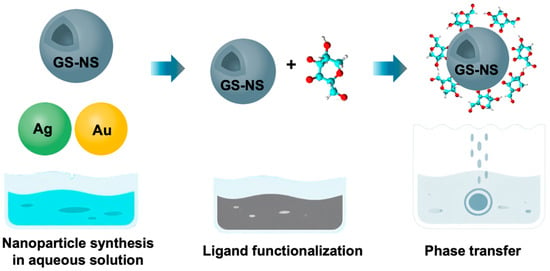Stabilizing the Localized Surface Plasmon Resonance (LSPR) of Citrate-Synthesized Metal Nanoparticles in Organic Solvents
Abstract
1. Introduction
2. Experimental Methods
2.1. Functionalization
2.2. Phase-Transfer
3. Results and Discussion
3.1. Synthesis and Morphology
3.2. Functionalization and Time-Resolved Phase-Transfer of GS-NSs
3.2.1. Ligand Exchange and Phase-Transfer Protocol for GS-NSs
3.2.2. Phase-Transfer of GS-NS@TritonX-100
3.2.3. Phase-Transfer of GS-NS@NaSt
3.2.4. Phase-Transfer of GS-NS@PVP
3.2.5. Phase-Transfer of GS-NS@HPC
3.3. Comparative Analysis of the Final Ligand Stability for GS-NSs
3.3.1. Final Stability of GS-NS@Ligand in EG
3.3.2. Final Stability of GS-NS@Ligand in THF
3.3.3. Final Stability of GS-NS@Ligand in DCM
3.3.4. Final Stability of GS-NS@Ligand in Toluene
3.4. Functionalization and Time-Resolved Phase-Transfers of AgNPs
3.4.1. Ligand Exchange and Phase-Transfer Protocol for AgNPs
3.4.2. Phase-Transfer of Ag@PVP
3.4.3. Phase-Transfer of Ag@HPC
3.5. Comparative Analysis of the Final Ligand Stability for AgNPs
Final Stability of Ag@Ligand in EG, THF, DCM, and Toluene
3.6. Functionalization and Phase-Transfers of AuNPs
Ligand Exchange and Phase-Transfer Protocol for AuNPs
3.7. Comparative Analysis of the Final Ligand Stability for AuNPs
Phase-Transfer and Final Stability of Au@Ligand in EG, THF, DCM, and Toluene
4. Conclusions
Supplementary Materials
Author Contributions
Funding
Data Availability Statement
Acknowledgments
Conflicts of Interest
References
- Faraday, M.X. The Bakerian Lecture—Experimental relations of gold (and other metals) to light. Philos. Trans. R. Soc. Lond. 1857, 147, 145–181. [Google Scholar]
- Medhi, R.; Marquez, M.D.; Lee, T.R. Visible-Light-Active Doped Metal Oxide Nanoparticles: Review of their Synthesis, Properties, and Applications. ACS Appl. Nano Mater. 2020, 3, 6156–6185. [Google Scholar] [CrossRef]
- Tran, H.-V.; Ngo, N.; Medhi, R.; Srinoi, P.; Liu, T.; Rittikulsittichai, S.; Lee, T. Multifunctional Iron Oxide Magnetic Nanoparticles for Biomedical Applications: A Review. Materials 2022, 15, 503. [Google Scholar] [CrossRef]
- Medhi, R.; Li, C.-H.; Lee, S.H.; Srinoi, P.; Marquez, M.D.; Robles-Hernandez, F.; Jacobson, A.J.; Lee, T.-C.; Lee, T.R. Antimony- and Zinc-Doped Tin Oxide Shells Coated on Gold Nanoparticles and Gold–Silver Nanoshells Having Tunable Extinctions for Sensing and Photonic Applications. ACS Appl. Nano Mater. 2020, 3, 8958–8971. [Google Scholar] [CrossRef]
- Jackson, J.B.; Halas, N.J. Silver Nanoshells: Variations in Morphologies and Optical Properties. J. Phys. Chem. B 2001, 105, 2743–2746. [Google Scholar] [CrossRef]
- Gellner, M.; Küstner, B.; Schlücker, S. Optical properties and SERS efficiency of tunable gold/silver nanoshells. Vib. Spectrosc. 2009, 50, 43–47. [Google Scholar] [CrossRef]
- Salorinne, K.; Man, R.W.Y.; Li, C.-H.; Taki, M.; Nambo, M.; Crudden, C.M. Water-Soluble N-Heterocyclic Carbene-Protected Gold Nanoparticles: Size-Controlled Synthesis, Stability, and Optical Properties. Angew. Chem. Int. Ed. 2017, 56, 6198–6202. [Google Scholar] [CrossRef] [PubMed]
- Ghodrati, M.; Mir, A.; Farmani, A. Numerical analysis of a surface plasmon resonance based biosensor using molybdenum disulfide, molybdenum trioxide, and MXene for the diagnosis of diabetes. Diam. Relat. Mater. 2023, 132, 109633. [Google Scholar] [CrossRef]
- Kravets, V.G.; Strudwick, A.; Grigorenko, A.N. Ultrathin Gold for Robust Multi-Element Surface Plasmon Resonance Biosensing. Adv. Mater. Interfaces 2025, 12, 2400925. [Google Scholar] [CrossRef]
- Aiken, J.D.; Finke, R.G. A review of modern transition-metal nanoclusters: Their synthesis, characterization, and applications in catalysis. J. Mol. Catal. A Chem. 1999, 145, 1–44. [Google Scholar] [CrossRef]
- Brust, M.; Fink, J.; Bethell, D.; Schiffrin, D.J.; Kiely, C. Synthesis and reactions of functionalised gold nanoparticles. J. Chem. Soc. Chem. Commun. 1995, 1655–1656. [Google Scholar] [CrossRef]
- Cheng, W.; Wang, E. Size-Dependent Phase Transfer of Gold Nanoparticles from Water into Toluene by Tetraoctylammonium Cations: A Wholly Electrostatic Interaction. J. Phys. Chem. B 2004, 108, 24–26. [Google Scholar] [CrossRef]
- Ferry, A.; Schaepe, K.; Tegeder, P.; Richter, C.; Chepiga, K.M.; Ravoo, B.J.; Glorius, F. Negatively Charged N-Heterocyclic Carbene-Stabilized Pd and Au Nanoparticles and Efficient Catalysis in Water. ACS Catal. 2015, 5, 5414–5420. [Google Scholar] [CrossRef]
- Kumar, A.; Mandal, S.; Mathew, S.P.; Selvakannan, P.R.; Mandale, A.B.; Chaudhari, R.V.; Sastry, M. Benzene- and Anthracene-Mediated Assembly of Gold Nanoparticles at the Liquid−Liquid Interface. Langmuir 2002, 18, 6478–6483. [Google Scholar] [CrossRef]
- Wei, G.-T.; Yang, Z.; Lee, C.-Y.; Yang, H.-Y.; Wang, C.R.C. Aqueous−Organic Phase Transfer of Gold Nanoparticles and Gold Nanorods Using an Ionic Liquid. J. Am. Chem. Soc. 2004, 126, 5036–5037. [Google Scholar] [CrossRef]
- Dreaden, E.C.; Alkilany, A.M.; Huang, X.; Murphy, C.J.; El-Sayed, M.A. The golden age: Gold nanoparticles for biomedicine. Chem. Soc. Rev. 2012, 41, 2740–2779. [Google Scholar] [CrossRef]
- MacLeod, M.J.; Johnson, J.A. PEGylated N-Heterocyclic Carbene Anchors Designed To Stabilize Gold Nanoparticles in Biologically Relevant Media. J. Am. Chem. Soc. 2015, 137, 7974–7977. [Google Scholar] [CrossRef]
- Sherman, L.M.; Finley, M.D.; Borsari, R.K.; Schuster-Little, N.; Strausser, S.L.; Whelan, R.J.; Jenkins, D.M.; Camden, J.P. N-Heterocyclic Carbene Ligand Stability on Gold Nanoparticles in Biological Media. ACS Omega 2022, 7, 1444–1451. [Google Scholar] [CrossRef] [PubMed]
- Wang, G.; Yan, C.; Gao, S.; Liu, Y. Surface chemistry of gold nanoparticles determines interactions with bovine serum albumin. Mater. Sci. Eng. C 2019, 103, 109856. [Google Scholar] [CrossRef] [PubMed]
- Soliman, M.G.; Pelaz, B.; Parak, W.J.; del Pino, P. Phase Transfer and Polymer Coating Methods toward Improving the Stability of Metallic Nanoparticles for Biological Applications. Chem. Mater. 2015, 27, 990–997. [Google Scholar] [CrossRef]
- Bryan, W.W.; Medhi, R.; Marquez, M.D.; Rittikulsittichai, S.; Tran, M.; Lee, T.R. Porous silver-coated pNIPAM-co-AAc hydrogel nanocapsules. Beilstein J. Nanotechnol. 2019, 10, 1973–1982. [Google Scholar] [CrossRef] [PubMed]
- Soliwoda, K.; Tomaszewska, E.; Tkacz-Szczesna, B.; Mackiewicz, E.; Rosowski, M.; Bald, A.; Blanck, C.; Schmutz, M.; Novák, J.; Schreiber, F.; et al. Effect of the Alkyl Chain Length of Secondary Amines on the Phase Transfer of Gold Nanoparticles from Water to Toluene. Langmuir 2014, 30, 6684–6693. [Google Scholar] [CrossRef]
- Medhi, R.; Plengjaroensirichai, S.; Ngo, N.; Marquez, M.D.; Srinoi, P.; Tran, H.-V.; Jacobson, A.J.; Lee, T.-C.; Lee, T.R. TiO2 core–shell and core-dual-shell nanoparticles with tunable heterojunctions and visible to near-infrared extinctions. Mater. Adv. 2024, 5, 1648–1666. [Google Scholar] [CrossRef]
- Attia, Y.; Samer, M. Metal clusters: New era of hydrogen production. Renew. Sustain. Energy Rev. 2017, 79, 878–892. [Google Scholar] [CrossRef]
- Li, C.-H.; Li, M.-C.; Liu, S.-P.; Jamison, A.C.; Lee, D.; Lee, T.R.; Lee, T.-C. Plasmonically Enhanced Photocatalytic Hydrogen Production from Water: The Critical Role of Tunable Surface Plasmon Resonance from Gold–Silver Nanoshells. ACS Appl. Mater. Interfaces 2016, 8, 9152–9161. [Google Scholar] [CrossRef] [PubMed]
- Agunloye, E.; Panariello, L.; Gavriilidis, A.; Mazzei, L. A Model for the Formation of Gold Nanoparticles in the Citrate Synthesis Method. Chem. Eng. Sci. 2018, 191, 318–331. [Google Scholar] [CrossRef]
- Feng, X.; Ma, H.; Huang, S.; Pan, W.; Zhang, X.; Tian, F.; Gao, C.; Cheng, Y.; Luo, J. Aqueous−Organic Phase-Transfer of Highly Stable Gold, Silver, and Platinum Nanoparticles and New Route for Fabrication of Gold Nanofilms at the Oil/Water Interface and on Solid Supports. J. Phys. Chem. B 2006, 110, 12311–12317. [Google Scholar] [CrossRef]
- Henglein, A. Physicochemical properties of small metal particles in solution: “microelectrode” reactions, chemisorption, composite metal particles, and the atom-to-metal transition. J. Phys. Chem. 1993, 97, 5457–5471. [Google Scholar] [CrossRef]
- Liu, J.; Alvarez, J.; Ong, W.; Román, E.; Kaifer, A.E. Phase Transfer of Hydrophilic, Cyclodextrin-Modified Gold Nanoparticles to Chloroform Solutions. J. Am. Chem. Soc. 2001, 123, 11148–11154. [Google Scholar] [CrossRef] [PubMed]
- Mayya, K.S.; Caruso, F. Phase Transfer of Surface-Modified Gold Nanoparticles by Hydrophobization with Alkylamines. Langmuir 2003, 19, 6987–6993. [Google Scholar] [CrossRef]
- Perala, S.R.K.; Kumar, S. On the Mechanism of Metal Nanoparticle Synthesis in the Brust–Schiffrin Method. Langmuir 2013, 29, 9863–9873. [Google Scholar] [CrossRef] [PubMed]
- Yuan, X.; Luo, Z.; Zhang, Q.; Zhang, X.; Zheng, Y.; Lee, J.Y.; Xie, J. Synthesis of Highly Fluorescent Metal (Ag, Au, Pt, and Cu) Nanoclusters by Electrostatically Induced Reversible Phase Transfer. ACS Nano 2011, 5, 8800–8808. [Google Scholar] [CrossRef] [PubMed]
- Lassiter, J.B.; Aizpurua, J.; Hernandez, L.I.; Brandl, D.W.; Romero, I.; Lal, S.; Hafner, J.H.; Nordlander, P.; Halas, N.J. Close Encounters between Two Nanoshells. Nano Lett. 2008, 8, 1212–1218. [Google Scholar] [CrossRef] [PubMed]
- Leff, D.V.; Brandt, L.; Heath, J.R. Synthesis and Characterization of Hydrophobic, Organically-Soluble Gold Nanocrystals Functionalized with Primary Amines. Langmuir 1996, 12, 4723–4730. [Google Scholar] [CrossRef]
- Yang, J.; Lee, J.Y.; Ying, J.Y. Phase transfer and its applications in nanotechnology. Chem. Soc. Rev. 2011, 40, 1672–1696. [Google Scholar] [CrossRef]
- Li, C.; Han, J.; Ryu, C.Y.; Benicewicz, B.C. A Versatile Method To Prepare RAFT Agent Anchored Substrates and the Preparation of PMMA Grafted Nanoparticles. Macromolecules 2006, 39, 3175–3183. [Google Scholar] [CrossRef]
- Mourdikoudis, S.; Menelaou, M.; Fiuza-Maneiro, N.; Zheng, G.; Wei, S.; Pérez-Juste, J.; Polavarapu, L.; Sofer, Z. Oleic acid/oleylamine ligand pair: A versatile combination in the synthesis of colloidal nanoparticles. Nanoscale Horiz. 2022, 7, 941–1015. [Google Scholar] [CrossRef]
- Kershaw, S.V.; Susha, A.S.; Rogach, A.L. Narrow bandgap colloidal metal chalcogenide quantum dots: Synthetic methods, heterostructures, assemblies, electronic and infrared optical properties. Chem. Soc. Rev. 2013, 42, 3033–3087. [Google Scholar] [CrossRef]
- Kumar, S.K.; Jouault, N.; Benicewicz, B.; Neely, T. Nanocomposites with Polymer Grafted Nanoparticles. Macromolecules 2013, 46, 3199–3214. [Google Scholar] [CrossRef]
- Ngo, N.M.; Nguyen, M.D.; Tran, H.-V.; Medhi, R.; Lee, J.M.; Lee, T.R. Photocatalytic Hydrogen Generation by Monodisperse TiO2 Nanoparticles Singly and Dually Doped with Niobium and Tantalum. ACS Appl. Nano Mater. 2025, 8, 4841–4851. [Google Scholar] [CrossRef]
- Wang, Y.C.; Rhéaume, É.; Lesage, F.; Kakkar, A. Synthetic Methodologies to Gold Nanoshells: An Overview. Molecules 2018, 23, 2851. [Google Scholar] [CrossRef]
- Sun, N.; Zhang, S.-T.; Simon, F.; Steiner, A.M.; Schubert, J.; Du, Y.; Qiao, Z.; Fery, A.; Lissel, F. Poly(3-hexylthiophene)s Functionalized with N-Heterocyclic Carbenes as Robust and Conductive Ligands for the Stabilization of Gold Nanoparticles. Angew. Chem. Int. Ed. 2021, 60, 3912–3917. [Google Scholar] [CrossRef]
- Schilter, D. Thiol oxidation: A slippery slope. Nat. Rev. Chem. 2017, 1, 0013. [Google Scholar] [CrossRef]
- Sardar, R.; Funston, A.M.; Mulvaney, P.; Murray, R.W. Gold Nanoparticles: Past, Present, and Future. Langmuir 2009, 25, 13840–13851. [Google Scholar] [CrossRef] [PubMed]
- Gittins, D.I.; Caruso, F. Spontaneous phase transfer of nanoparticulate metals from organic to aqueous media. Angew. Chem. Int. Ed. Engl. 2001, 40, 3001–3004. [Google Scholar] [CrossRef] [PubMed]
- Honold, T.; Skrybeck, D.; Wagner, K.G.; Karg, M. Fully Reversible Quantitative Phase Transfer of Gold Nanoparticles Using Bifunctional PNIPAM Ligands. Langmuir 2017, 33, 253–261. [Google Scholar] [CrossRef]
- Imura, Y.; Morita, C.; Endo, H.; Kondo, T.; Kawai, T. Reversible phase transfer and fractionation of Au nanoparticles by pH change. Chem. Commun. 2010, 46, 9206–9208. [Google Scholar] [CrossRef]
- Karaagac, Z.; Yusufbeyoglu, S.; Ildiz, N.; Sellami, H.; Ocsoy, I. A facile and one-pot aqueous phase transfer of oleylamine capped Au NP with aminophenylboronic acid used as transfer and targeting ligand. Enzyme Microb. Technol. 2021, 148, 109810. [Google Scholar] [CrossRef]
- Lala, N.; Lalbegi, S.P.; Adyanthaya, S.D.; Sastry, M. Phase Transfer of Aqueous Gold Colloidal Particles Capped with Inclusion Complexes of Cyclodextrin and Alkanethiol Molecules into Chloroform. Langmuir 2001, 17, 3766–3768. [Google Scholar] [CrossRef]
- McMahon, J.M.; Emory, S.R. Phase Transfer of Large Gold Nanoparticles to Organic Solvents with Increased Stability. Langmuir 2007, 23, 1414–1418. [Google Scholar] [CrossRef]
- Nosratabad, N.A.; Jin, Z.; Du, L.; Thakur, M.; Mattoussi, H. N-Heterocyclic Carbene-Stabilized Gold Nanoparticles: Mono- Versus Multidentate Ligands. Chem. Mater. 2021, 33, 921–933. [Google Scholar] [CrossRef]
- Peng, Z.; Walther, T.; Kleinermanns, K. Photofragmentation of Phase-Transferred Gold Nanoparticles by Intense Pulsed Laser Light. J. Phys. Chem. B 2005, 109, 15735–15740. [Google Scholar] [CrossRef] [PubMed]
- Templeton, A.C.; Hostetler, M.J.; Warmoth, E.K.; Chen, S.; Hartshorn, C.M.; Krishnamurthy, V.M.; Forbes, M.D.E.; Murray, R.W. Gateway Reactions to Diverse, Polyfunctional Monolayer-Protected Gold Clusters. J. Am. Chem. Soc. 1998, 120, 4845–4849. [Google Scholar] [CrossRef]
- Wong-u-ra, O.; Ekgasit, S.; Wongravee, K. Phase transferring of silver nanoparticles to organic solvents using modified graphene oxide as carrier. Mater. Chem. Phys. 2017, 199, 348–355. [Google Scholar] [CrossRef]
- Schwartzberg, A.M.; Olson, T.Y.; Talley, C.E.; Zhang, J.Z. Synthesis, Characterization, and Tunable Optical Properties of Hollow Gold Nanospheres. J. Phys. Chem. B 2006, 110, 19935–19944. [Google Scholar] [CrossRef]
- Hirsch, L.R.; Gobin, A.; Lowery, A.R.; Tam, F.; Drezek, R.A.; Halas, N.J.; West, J.L. Metal Nanoshells. Ann. Biomed. Eng. 2005, 34, 15–22. [Google Scholar] [CrossRef]
- Borah, R.; Verbruggen, S.W. Silver–Gold Bimetallic Alloy versus Core–Shell Nanoparticles: Implications for Plasmonic Enhancement and Photothermal Applications. J. Phys. Chem. C 2020, 124, 12081–12094. [Google Scholar] [CrossRef]
- Gheorghe, D.E.; Cui, L.; Karmonik, C.; Brazdeikis, A.; Penaloza, J.M.; Young, J.K.; Drezek, R.A.; Bikram, M. Gold-silver alloy nanoshells: A new candidate for nanotherapeutics and diagnostics. Nanoscale Res. Lett. 2011, 6, 554. [Google Scholar] [CrossRef] [PubMed]
- Li, H.; Xia, H.; Wang, D.; Tao, X. Simple Synthesis of Monodisperse, Quasi-spherical, Citrate-Stabilized Silver Nanocrystals in Water. Langmuir 2013, 29, 5074–5079. [Google Scholar] [CrossRef]
- Smoliarova, T.E. Synthesis, properties and functionalization of gold nanostars for medical diagnostics. Sib. Med. Rev. 2021, 2, 97–99. [Google Scholar] [CrossRef]
- Spirin, M.G.; Brichkin, S.B.; Razumov, V.F. Studies on absorption spectra of uniform gold nanoparticles prepared in Triton X-100 reverse micelles. J. Photochem. 2008, 196, 174–179. [Google Scholar] [CrossRef]
- Baig, M.M.; Yousuf, M.A.; Zulfiqar, S.; Safeer, A.; Agboola, P.O.; Shakir, I.; Warsi, M.F. Structural and electrical properties of La3+ ions substituted MnFe2O4 ferrite nanoparticles synthesized via cost-effective reverse micelles strategy. Mater. Res. Express 2021, 8, 035002. [Google Scholar] [CrossRef]
- Bartokova, B.; Laredo, T.; Marangoni, A.G.; Pensini, E. Mechanism of tetrahydrofuran separation from water by stearic acid. J. Mol. Liq. 2023, 391, 123262. [Google Scholar] [CrossRef]
- Mireles, L.K.; Wu, M.-R.; Saadeh, N.; Yahia, L.H.; Sacher, E. Physicochemical Characterization of Polyvinyl Pyrrolidone: A Tale of Two Polyvinyl Pyrrolidones. ACS Omega 2020, 5, 30461–30467. [Google Scholar] [CrossRef] [PubMed]
- Grzymski, G.A.; Medhi, R. Surface Wettability Characteristics of Polymer Blend Coatings. Int. J. Math. Phys. Sci. Res. 2025, 12, 65–76. [Google Scholar]
- Choi, Y.; Hong, S.; Liu, L.; Kim, S.K.; Park, S. Galvanically Replaced Hollow Au–Ag Nanospheres: Study of Their Surface Plasmon Resonance. Langmuir 2012, 28, 6670–6676. [Google Scholar] [CrossRef]
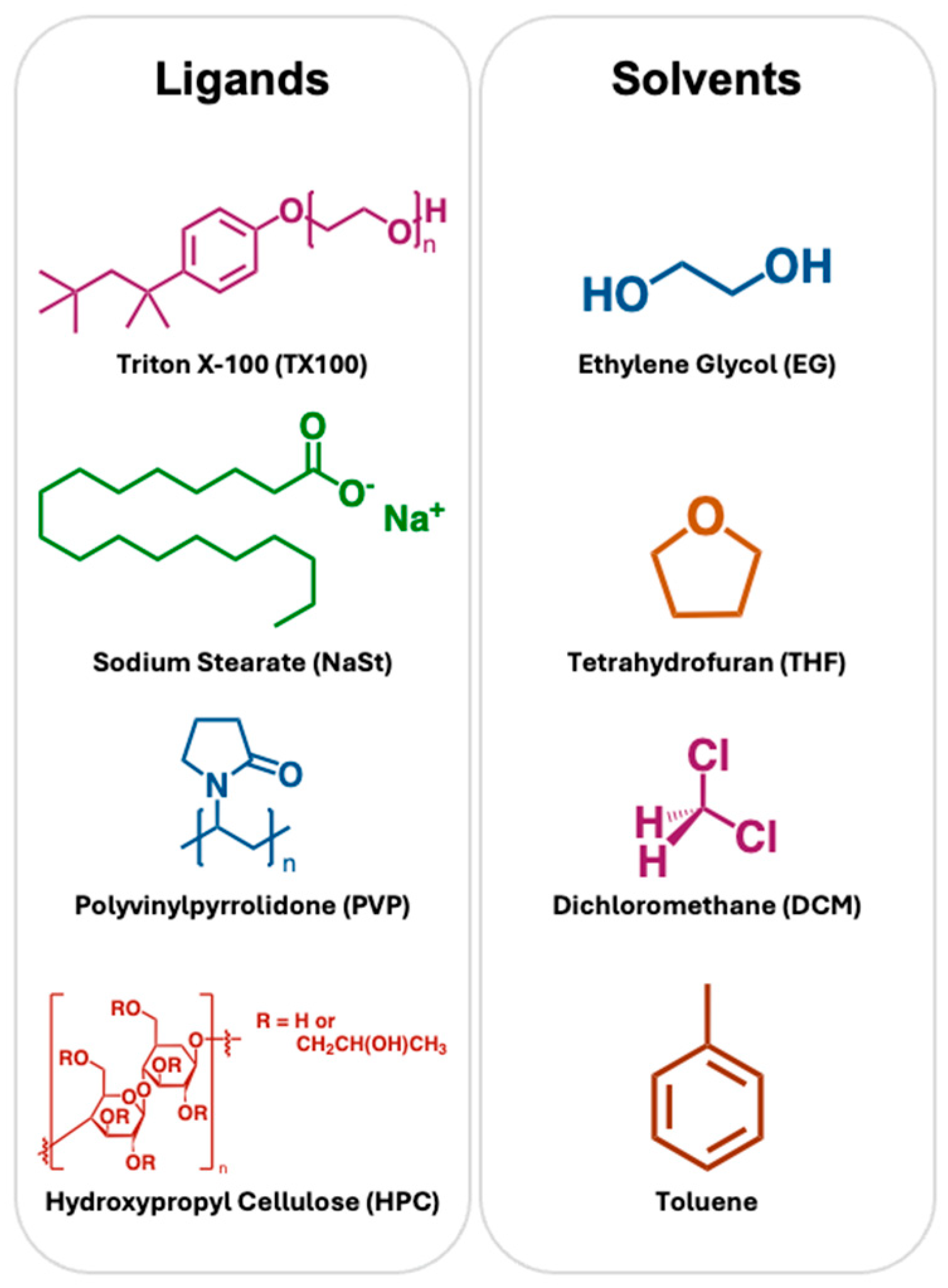
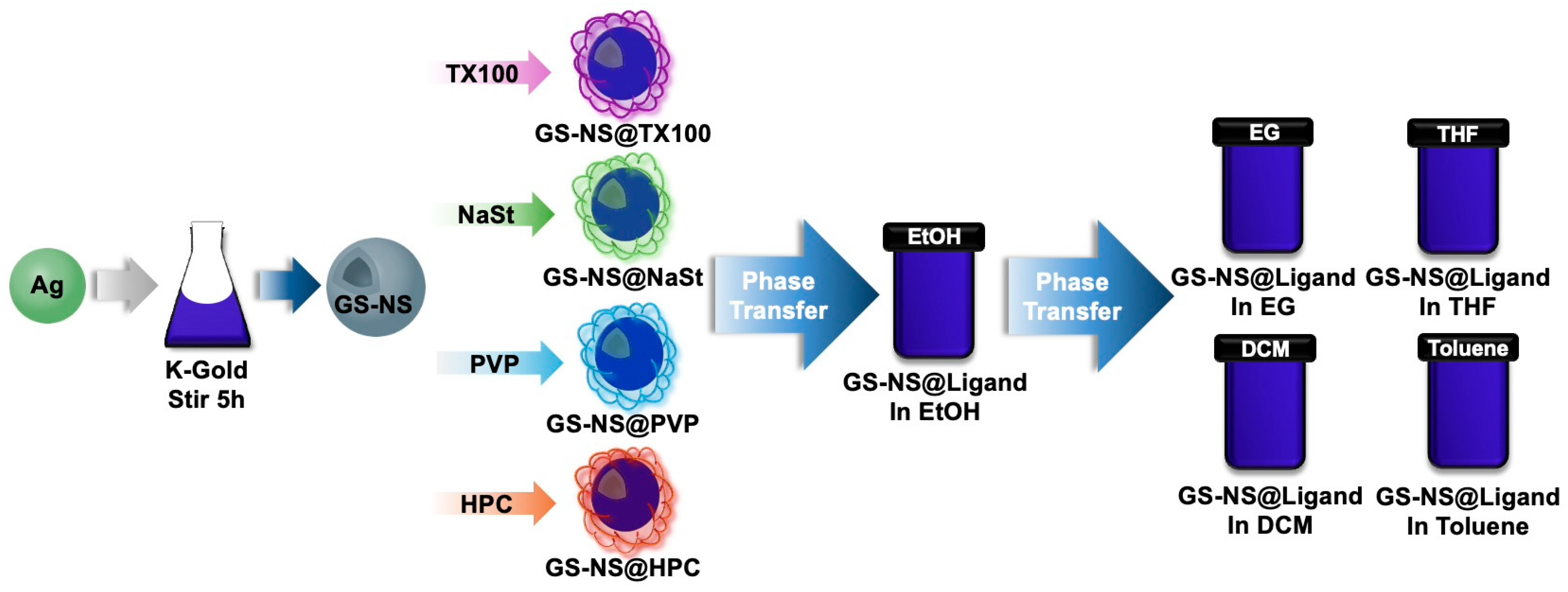

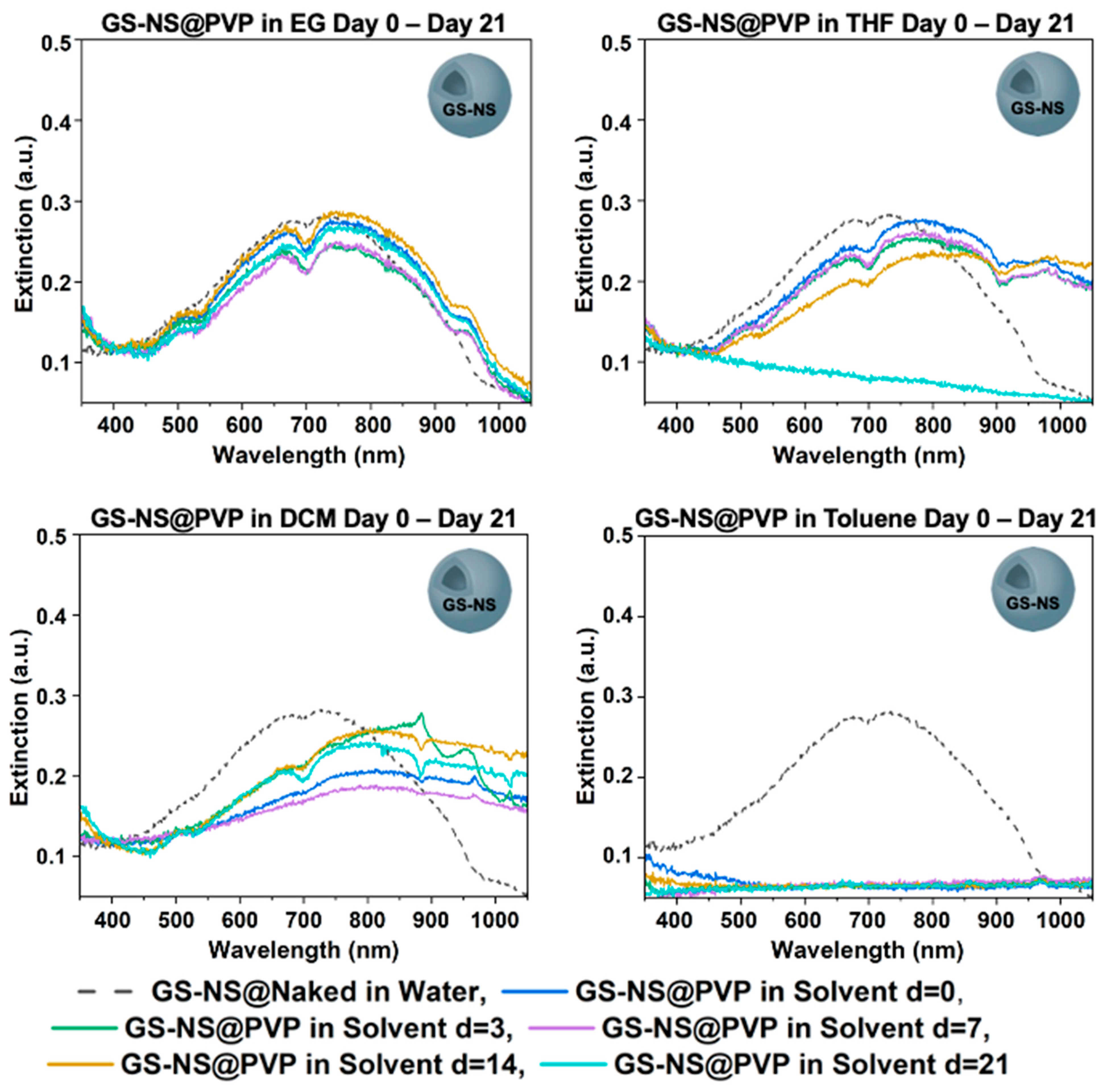
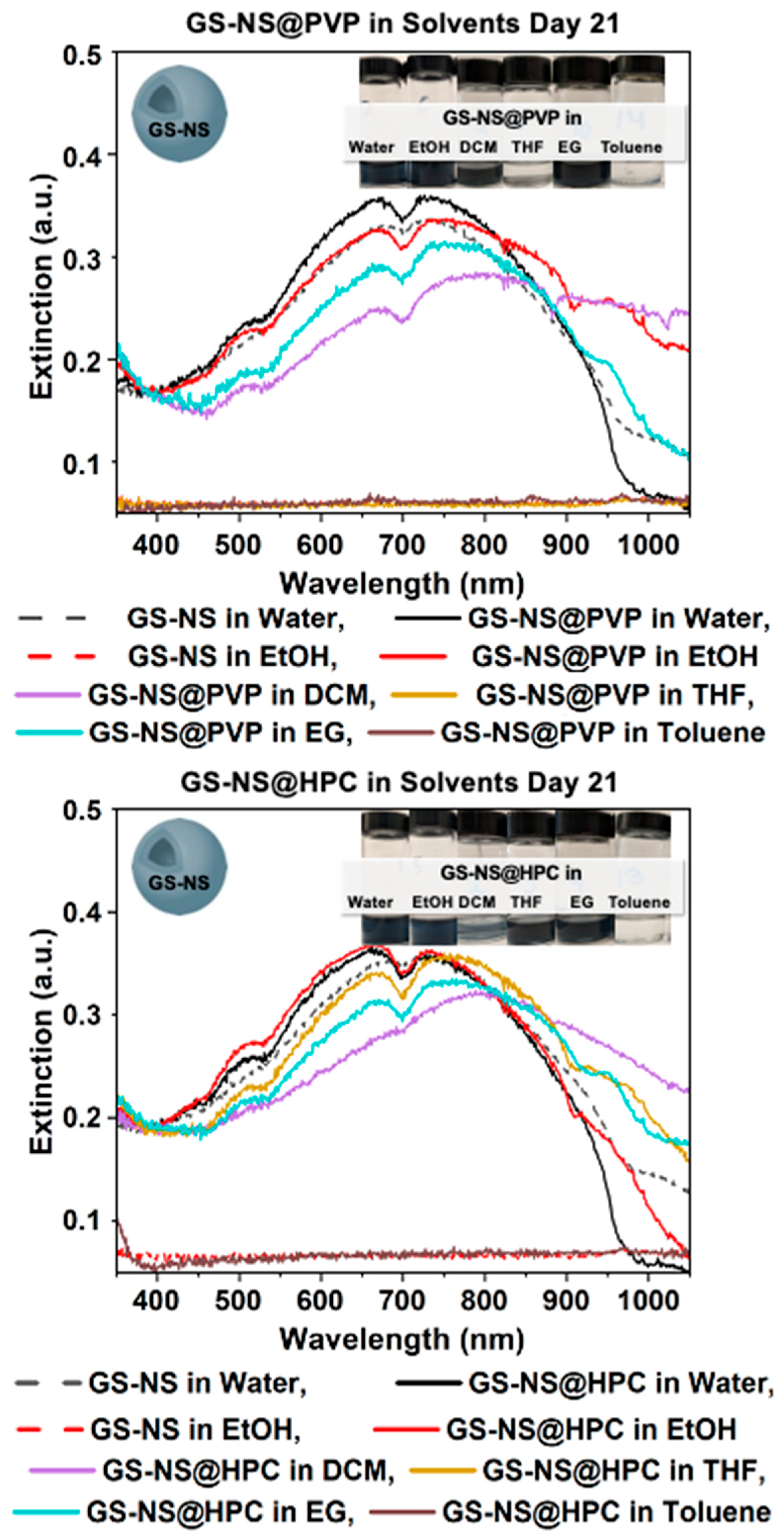

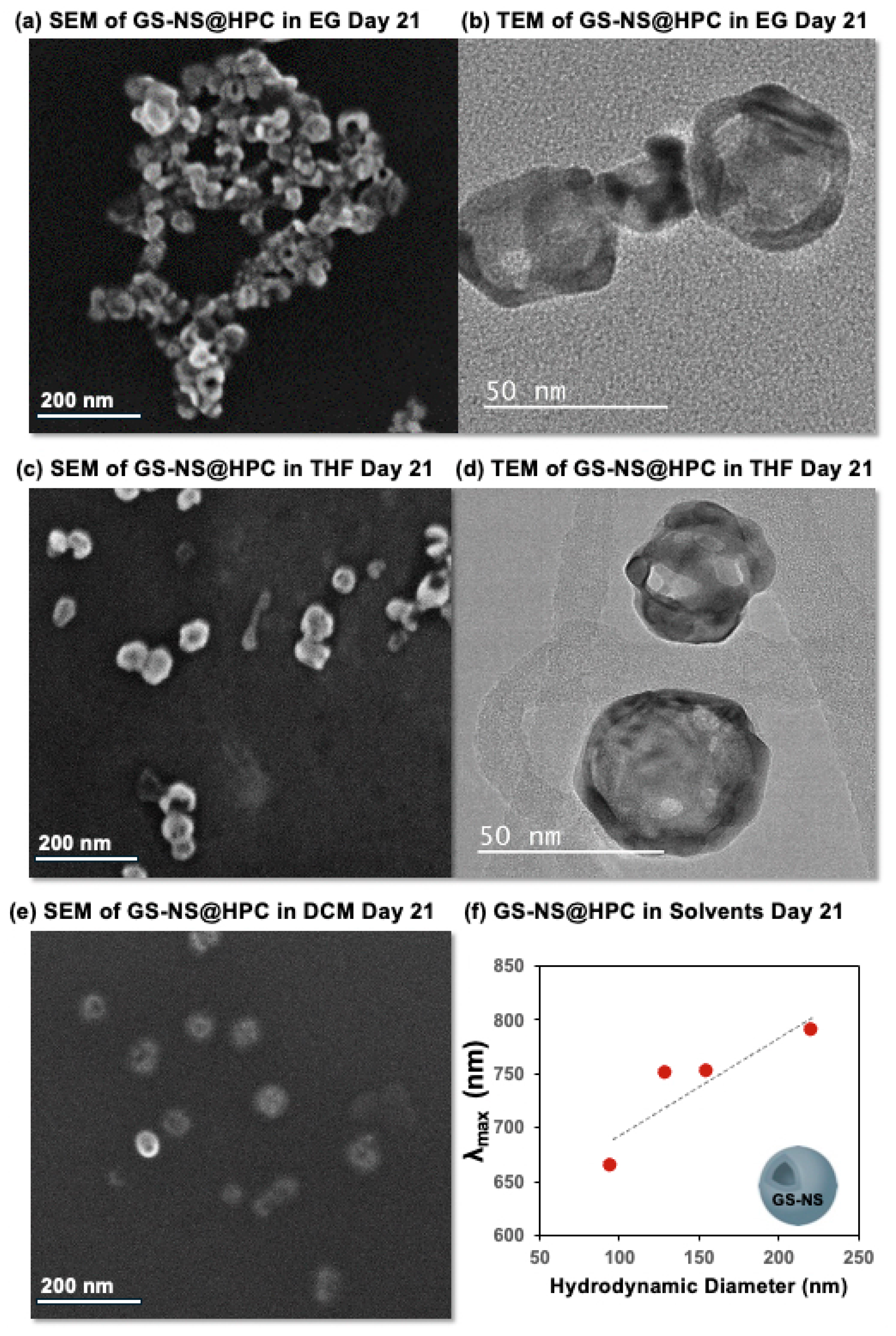


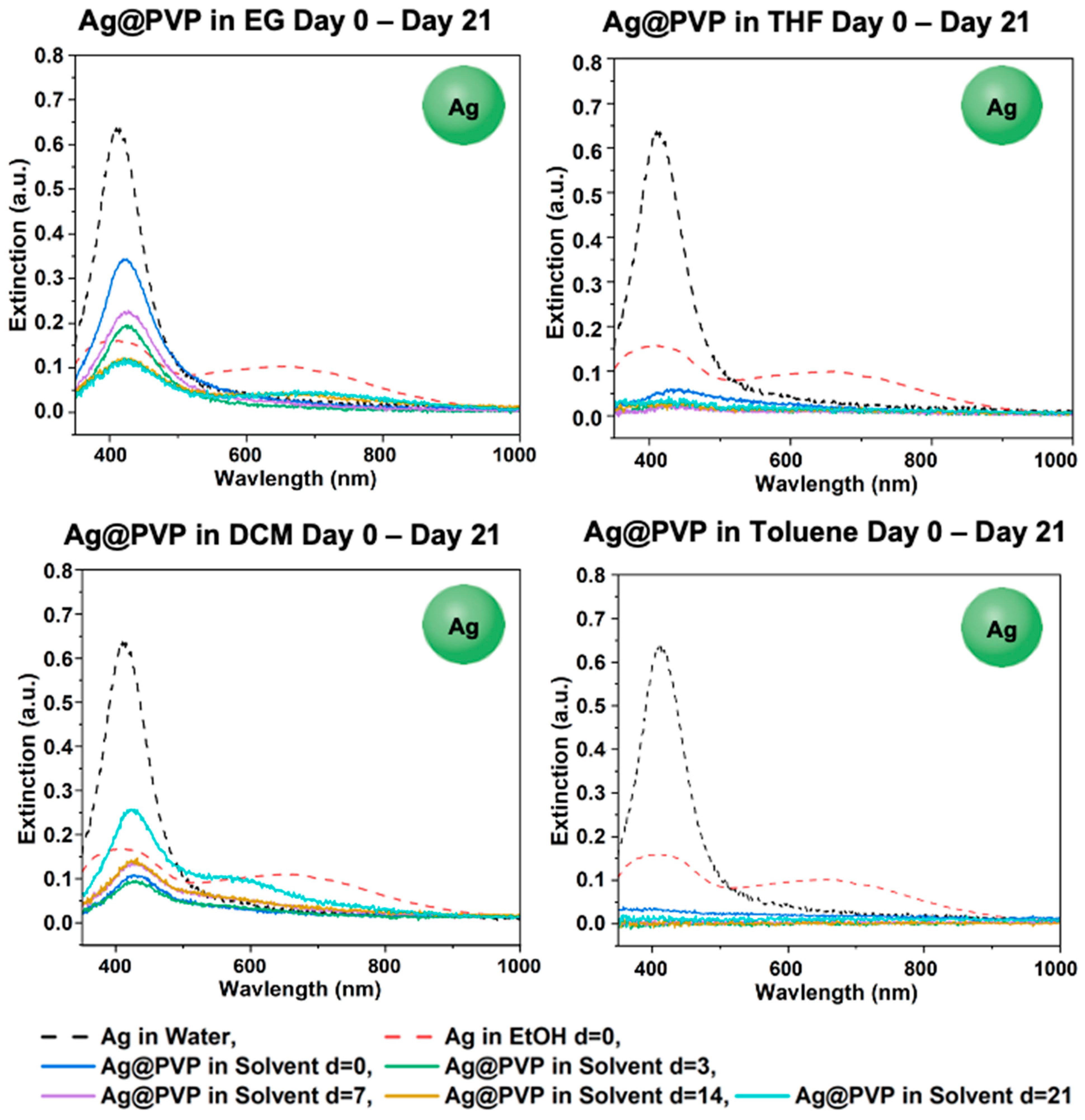
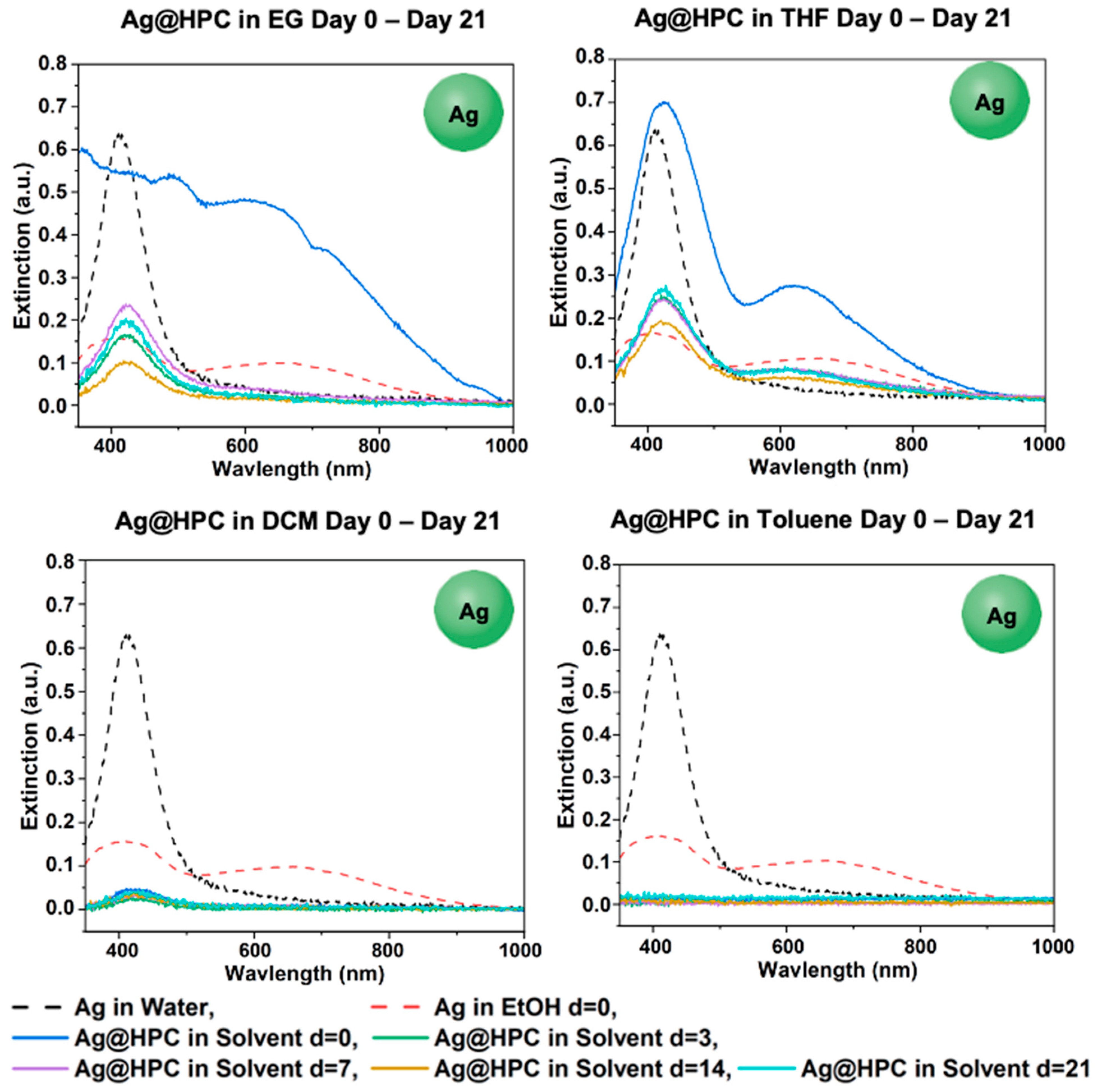

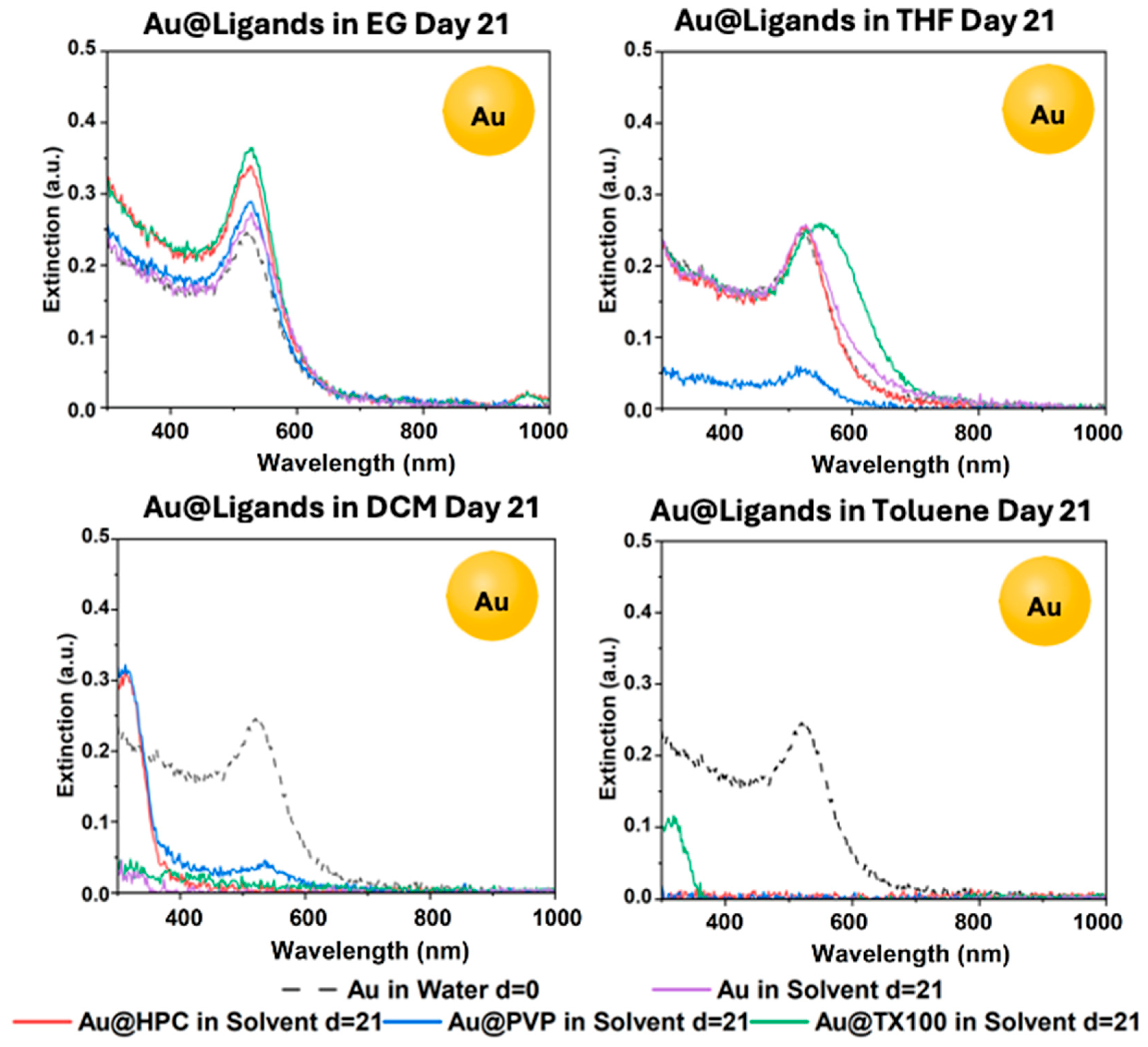
| Particle | Property | Solvent | |||||
|---|---|---|---|---|---|---|---|
| Water | EtOH | DCM | THF | EG | Toluene | ||
| GS-NS | Λmax d = 21 (nm) | 727 | Agg | Agg | Agg | Agg | Agg |
| ζ (mV) | −42 | N/A | N/A | N/A | N/A | - | |
| H.D. (nm) | 74.1 | N/A | N/A | N/A | N/A | N/A | |
| Particle Size (nm) | 46.5 | N/A | N/A | N/A | N/A | N/A | |
| GS-NS@HPC | Λmax d = 21 (nm) | 663 | 666 | 790 | 753 | 749 | Agg |
| ζ (mV) | −28.5 | −21.7 | - | - | - | - | |
| H.D. (nm) | 96.2 | 125.9 | 221.7 | 154.9 | 129.4 | N/A | |
| Particle Size (nm) | 42.9 | 50.7 | 50.7 | 51.2 | 43.5 | N/A | |
| GS-NS@PVP | Λmax d = 21 (nm) | 728 | 752 | 788 | Agg | 750 | Agg |
| ζ (mV) | −42.8 | −1.21 | - | N/A | - | - | |
| H.D. (nm) | 76.1 | 144.9 | 306.1 | N/A | 29.6 | N/A | |
| Particle Size (nm) | 44.1 | 42.1 | 50.6 | N/A | 49.1 | N/A | |
| GS-NS@NaSt | Λmax d = 21 (nm) | 728 | Agg | Agg | Agg | 803 | Agg |
| ζ (mV) | −51.4 | N/A | N/A | N/A | - | - | |
| H.D. (nm) | 87.1 | N/A | N/A | N/A | Agg | N/A | |
| Particle Size (nm) | 48.7 | N/A | N/A | N/A | N/A | N/A | |
| GS-NS@TX100 | Λmax d = 21 (nm) | 742 | Agg | Agg | 663 | 761 | 782 |
| ζ (mV) | −31.3 | N/A | N/A | - | - | - | |
| H.D. (nm) | 76.9 | N/A | N/A | Agg | 97.7 | 684.8 | |
| Particle Size (nm) | 47.9 | N/A | N/A | Agg | 59.9 | 73.2 | |
Disclaimer/Publisher’s Note: The statements, opinions and data contained in all publications are solely those of the individual author(s) and contributor(s) and not of MDPI and/or the editor(s). MDPI and/or the editor(s) disclaim responsibility for any injury to people or property resulting from any ideas, methods, instructions or products referred to in the content. |
© 2025 by the authors. Licensee MDPI, Basel, Switzerland. This article is an open access article distributed under the terms and conditions of the Creative Commons Attribution (CC BY) license (https://creativecommons.org/licenses/by/4.0/).
Share and Cite
Magdon, J.P.; Jasienski, M.J.; Waltz, M.R.; Grzymski, G.A.; Chen, C.; Solomon, A.M.; Nguyen, M.D.; Lee, J.M.; Deàk, J.C.; Lee, T.R.; et al. Stabilizing the Localized Surface Plasmon Resonance (LSPR) of Citrate-Synthesized Metal Nanoparticles in Organic Solvents. Materials 2025, 18, 5246. https://doi.org/10.3390/ma18225246
Magdon JP, Jasienski MJ, Waltz MR, Grzymski GA, Chen C, Solomon AM, Nguyen MD, Lee JM, Deàk JC, Lee TR, et al. Stabilizing the Localized Surface Plasmon Resonance (LSPR) of Citrate-Synthesized Metal Nanoparticles in Organic Solvents. Materials. 2025; 18(22):5246. https://doi.org/10.3390/ma18225246
Chicago/Turabian StyleMagdon, Jacob P., Matthew J. Jasienski, Madison R. Waltz, Gabrielle A. Grzymski, Calvin Chen, Arion M. Solomon, Minh Dang Nguyen, Jong Moon Lee, John C. Deàk, T. Randall Lee, and et al. 2025. "Stabilizing the Localized Surface Plasmon Resonance (LSPR) of Citrate-Synthesized Metal Nanoparticles in Organic Solvents" Materials 18, no. 22: 5246. https://doi.org/10.3390/ma18225246
APA StyleMagdon, J. P., Jasienski, M. J., Waltz, M. R., Grzymski, G. A., Chen, C., Solomon, A. M., Nguyen, M. D., Lee, J. M., Deàk, J. C., Lee, T. R., & Medhi, R. (2025). Stabilizing the Localized Surface Plasmon Resonance (LSPR) of Citrate-Synthesized Metal Nanoparticles in Organic Solvents. Materials, 18(22), 5246. https://doi.org/10.3390/ma18225246





